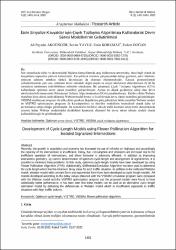| dc.contributor.author | Akgüngör, Ali Payıdar | |
| dc.contributor.author | Yavuz, Sevim | |
| dc.contributor.author | Korkmaz, Ersin | |
| dc.contributor.author | Doğan, Erdem | |
| dc.date.accessioned | 2021-01-14T18:22:09Z | |
| dc.date.available | 2021-01-14T18:22:09Z | |
| dc.date.issued | 2020 | |
| dc.identifier.issn | 2147-3129 | |
| dc.identifier.issn | 2147-3188 | |
| dc.identifier.uri | https://app.trdizin.gov.tr/makale/TXpjNU16STFOUT09 | |
| dc.identifier.uri | https://hdl.handle.net/20.500.12587/14070 | |
| dc.description.abstract | Son zamanlarda nüfus ve ekonomideki büyüme karayollarında araç kullanımını arttırmakta, buna bağlı olarak da kavşakların kapasitesi yetersiz kalmaktadır. Kavşakların verimsiz çalışmasından dolayı gecikme, yakıt tüketimi, emisyon salınımı artarken sürücü davranışları da olumsuz etkilenmektedir. Kavşak geometrilerinin iyileştirilmesinin yanı sıra, optimum devre süresinin doğru tespiti ve sinyal sürelerinin düzenlenmesi ile de bu sorunların minimuma indirilebilmesi mümkün olmaktadır. Bu çalışmada Çiçek Tozlaşma Algoritması (ÇTA) kullanılarak optimum devre süresi modelleri geliştirilmiştir. Ayrıca en düşük gecikmeye sahip olan devre sürelerinin belirlenmesinde Diferansiyel Gelişim Algoritmasından (DGA) yararlanılmıştır. Kalibre edilen Webster modeline ilave olarak sabit eklenmiş Webster model formu ve üstel formda devre süresi modelleri geliştirilmiştir. VISSIM simülasyon programı ile elde edilen gecikme değerlerine göre geliştirilen bütün modeller Webster modeli ve VISTRO optimizasyon programı ile karşılaştırılmış ve önerilen modellerin istatistiksel olarak daha iyi performansa sahip olduğu görülmüştür. Bu modellerin özellikle yüksek trafik hacmine sahip trafik durumlarında yetersiz kalan Webster modelindeki eksiklikleri kapatarak alternatif bir devre süresi tahmin modeli olarak kullanılabileceği ön görülmektedir. | en_US |
| dc.description.abstract | Recently, the growth in population and economy has increased the use of vehicles on highways and accordingly the capacity of the intersections is insufficient. Delay, fuel consumption and emissions are increased due to the inefficient operation of intersections, and driver behavior is adversely affected. In addition to improving intersection geometry, by correct determination of optimum cycle length and arrangement of signal times, it is possible to minimize these problems. In this study, optimum cycle length models have been developed by using Flower Pollination Algorithm (FPA). Additionally, Differential Evolution Algorithm has been used to determine the cycle length which has the minimum delay value for each traffic situation. In addition to the calibrated Webster model, Webster model with constant form and exponential form have been developed as cycle length models. All models developed according to the delay values obtained with the VISSIM simulation program were compared with the Webster model and the VISTRO optimization program and the proposed models were found to have statistically better performance. It has been seen that these models can be used as an alternative cycle length estimation model by defeating the deficiencies in Webster model which is insufficient especially in traffic situations with high traffic volume. | en_US |
| dc.language.iso | tur | en_US |
| dc.rights | info:eu-repo/semantics/openAccess | en_US |
| dc.title | İzole Sinyalize Kavşaklar için Çiçek Tozlaşma Algoritması Kullanılarak Devre Süresi Modellerinin Geliştirilmesi | en_US |
| dc.title.alternative | Development of Cycle Length Models using Flower Pollination Algorithm for Isolated Signalized Intersections | en_US |
| dc.type | article | en_US |
| dc.identifier.volume | 9 | en_US |
| dc.identifier.issue | 3 | en_US |
| dc.identifier.startpage | 1401 | en_US |
| dc.identifier.endpage | 1414 | en_US |
| dc.relation.journal | Bitlis Eren Üniversitesi Fen Bilimleri Dergisi | en_US |
| dc.relation.publicationcategory | Makale - Ulusal Hakemli Dergi - Kurum Öğretim Elemanı | en_US |
















